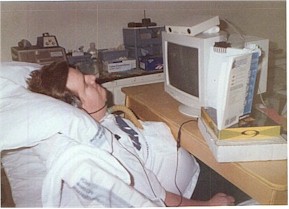VentWorld.com first found out about him at the end of March when he was vying for (and won) a mini color video camera from X10, Inc. Mr. Parker wanted the camera to monitor the progress of his pregnant friend, Angie, a good friend who helped him through tough times after a diving accident in 1991 left him paralyzed virtually from the neck down.
Parker today is a web developer, consultant, and vent user pioneer. With a grant from The Able Trust (www.abletrust.org), he also has started a small business repairing computers, and purchased a web server that hosts more than 30 domain names with ongoing expansion. He tells part of his story on his website, http://members.aol.com/TJPathome/, about how his environmental control system called "Max® " (by Multimedia Designs) and the Head Mouse® (Origin Instruments) have changed his life, allowing him a certain level of independence, from opening doors, changing television channels, to even faxing letters, surfing the Internet, developing web pages, and hosting sites on his server. In a recent conversation with him, we discovered other parts of his story that reveal his energy and passion. These have enabled him to overcome many physical and not-so-physical obstacles, including state legislation that limits access to the most appropriate equipment ("I’ve shook things up in Florida and opened doors for others by working behind the scenes to get programs started") and caregivers’ stubborn resistance towards listening to their patients.
Knowing What Works for Each Vent User
"The problem many people on a vent have is that they let their doctors sometimes tell them what to do too much," he states. "Everyone on a vent is different. I know what is comfortable for me. If I need more, I crank it up." While he doesn’t advise others to arbitrarily change their vent settings, he feels that many doctors don’t take the time to find out what is comfortable for the vent user, and the vent user may be afraid to challenge the doctors’ orders.
One explanation, offered by vent users interviewed for this article, is that vent users resist being more assertive because their life literally depends on those who care for them. If the caregivers aren’t informed about all the treatment options, particularly as it relates to equipment, new technologies, and techniques, then the vent user may suffer needlessly.
Parker has investigated many treatment options. At the time of this interview, he was using an LP-10 (Mallinckrodt/Puritan Bennett) but was going to switch to the LTV-900 (Pulmonetic Systems) When asked about treatment using phrenic nerve stimulation, he responded: "It could be fine for some people, but when I tried it, it didn’t help. My left side wasn’t working, and I couldn’t sit up or eat, and still had trouble breathing."
Max, the Head Mouse, and the Internet
Parker speaks enthusiastically about the way Max and the Head Mouse, especially in the Internet age, have changed his life. What started as a basic computer system to help him control his environment has become much more. After referrals through his psychologist and a vocational rehabilitation organization, Parker met Dan Deignan at Multimedia Designs. Six months and much paperwork later, Parker started using Max. At first, he was trying to use a speech-recognition program to interface with the computer, but this could get tiring (and slow), and he wanted to use the computer without his speaking valve. "Dan found the Head Mouse." When VentWorld asked about other input devices, such as dictation programs and sip-and-puff, Parker said that he finds the Head Mouse much better.
The Head Mouse is a system that combines a dot he puts on the tip of his nose with a sensor that tracks the dot. Navigation and input is accomplished by the user’s head movement. The Head Mouse costs about two thousand dollars, and the complete Multimedia Max system is around $8,000, which does not include the Head Mouse, but has "all the bells and whistles" for environmental control and computer control plus training. Parker is the technical support contact for Multimedia Designs Inc. Anyone with questions about Max (or the Head Mouse) can email him at TJPathome@aol.com.
On his website (that he created and manages), Parker shows visitors how he uses the Head Mouse to navigate, type, and perform the same function as one would with a keyboard and mouse. In fact, he states that the Head Mouse allows him to navigate and click faster than most people. In addition to web design, he’s working now to interface the navigation with DirectX® (Microsoft), a software technology used in the majority of PC games today. An avid race car fan, Parker is looking forward to the day he can play racing video games using his system.
The Internet has opened up a new world for Parker, and he is seizing this opportunity. Many have commented that the Internet has a potentially enormous impact on vent users by bringing their friends and the world into their homes. Also, it provides an alternative communication medium to speaking, which can be difficult for some. The combination of the Internet and enhanced communication tools may be an effective way to combat the isolation that vent users feel. Parker is eager to develop and assist in developing new technologies for himself and for others with physical challenges, as well as to pave the way for vent users to take an active part in their own care. If what he has done so far is any indication, then things certainly are going to happen.

